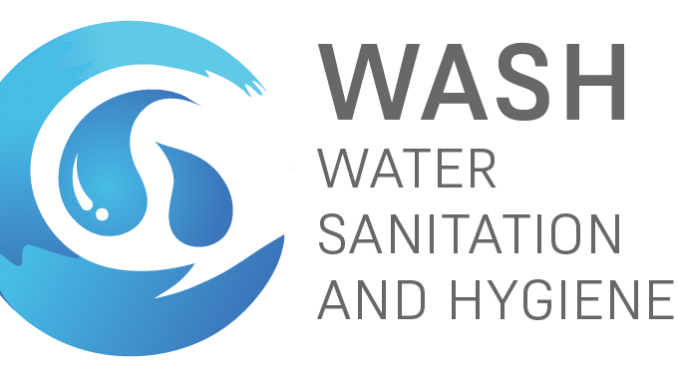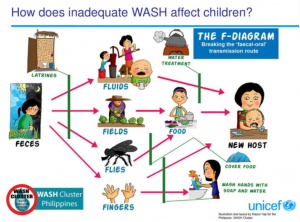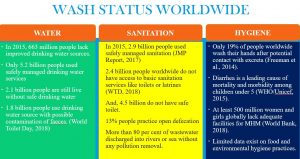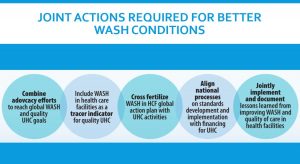
Table of Contents
What is WASH?
- WASH stands for:
- WA- Water
- S- Sanitation
- H- Hygiene
- Water: Essential liquid for survival of human, animals and plants. It includes:
- Access and availability of safe drinking water
- Access to adequate water supply
- Sanitation: Conditions related to clean drinking water and adequate treatment and disposal of human excreta and sewage. It includes:
- Clean toilets
- Access and practice of basic latrines and techniques to distinct human waste from interaction with people
- Management of water and waste material
- Clean household/environment
- One key area of works for sanitation is to finish the exercise of “open defecation,” and enable community-led resourcefulness to construct, uphold and practice basic toilets.
- Hygiene: Hygiene is vital to avoid disease and health of the children. It includes:
- Personal hygiene
- Handwashing with soap
- Menstrual hygiene
- Food hygiene
Key Concept of Water, Sanitation, and Hygiene (WASH):
- WASH is the combined term for Water, Sanitation, and Hygiene.
- In 2010, the United Nations General Assembly explicitly recognized water and sanitation as human rights that are “essential for the full enjoyment of life and all human rights”.
- Due to the codependent nature of these three components, these three core concerns are gathered together.
- WASH services offer for water accessibility and quality, attendance of sanitation services and availability of soap and water for hand washing.
- Sufficient water, hygiene, and sanitization are also the crucial constituents of providing basic health facilities.

- Although each one is a distinct field of work, each is reliant on the existence of the other. For example, lack of toilets can lead to contaminated water sources, lack of clean water leads to poor basic hygiene practices etc.
- The five principles of sustainable WASH are:
WASH Status Worldwide:
Water Status:
- In 2015, 663 million people lack improved drinking water sources.
- Only 5.2 billion people used safely managed drinking water services
- 1 billion people are still live without safe drinking water
- 8 billion people use drinking water source with possible contamination of faeces. (World Toilet Day, 2018)
Sanitation Status:
- In 2015, 2.9 billion people used safely managed sanitation (JMP Report, 2017)
- 4 billion people worldwide do not have access to basic sanitation services like toilets or latrines (WTD, 2018)
- And, 4.5 billion do not have safe toilet.
- 13% people practice open defecation
- 40% people used basic with none used safely managed sanitation in landlocked developing countries (JMP Report, 2017)
- More than 80 per cent of wastewater discharged into rivers or sea without any pollution removal.
Hygiene Status:
- Only 19% of people worldwide wash their hands after potential contact with excreta (Freeman et al., 2014).
- Diarrhea is a leading cause of mortality and morbidity among children under 5 (WHO/Unicef, 2015).
- At least 500 million women and girls globally lack adequate facilities for MHM (World Bank, 2018).
- Limited data exist on food and environmental hygiene practices.

Why is WASH Necessary?
- Adequate water, sanitation and hygiene are essential components of providing basic health services.
- Effective WASH interventions are critical to save the lives of the children.
- Clean water, basic toilets and good hygiene practices are essential for the survival and development of children. Without this, millions of children are at risk.
- For children under five years of age, water- and sanitation-related diseases are one of the leading causes of death.
- Over 700 children under age 5 die every day of diarrheal diseases due to lack of appropriate WASH services. (UNICEF)
- 297,000 children under five years of age die annually from diarrheal diseases due to poor sanitation, poor hygiene, or unsafe drinking water.
- Evidence suggests that washing hands with soap after defecation and before eating food can cut the respiratory infection rate by up to 25%.
- Poor WASH measures increase the barriers to children’s attendance and performance in schools, especially those of girls.
- Thus, appropriate WASH measures:
- Prevent infections and spread of diseases.
- Prevents 9.1% of the global disease burden and 6.3% of all deaths
- Decrease diarrhea associated deaths.
- Reduces the rate of diarrhea and respiratory infection.
- Improvement of drinking-water quality, such as point-of-use disinfection, would lead to a 45% reduction of diarrhea episodes
- Increases survival and development of children.
- Increases economic benefits ranging from $ 5 to $ 46 per US$ 1 invested
| Activity | % reduction in diarrheal morbidity |
| Improved water sources | 21% |
| Improved sanitation | 37.5% |
| Washing hands at critical times | 35% |
WASH: Disease and Death
- Each year diarrhea kills 760,000 children <5 Years, making it a leading cause of child mortality
- 88% of deaths from diarrhea are due to inadequate WASH.
- Worldwide, soil-transmitted helminths infect more than one billion people due to a lack of adequate sanitation.
- Malnutrition: Diarrheal episodes are responsible for 1/4th of stunting
- Poor WASH is also strongly associated with malaria, polio and neglected tropical diseases (NTDs) like guinea worm, schistosomiasis, helminths and trachoma that have a debilitating effect on children and their families.
- Reports estimate that people with WASH related diseases fill half of hospital beds in developing countries.
- The burden on health systems globally is growing and inadequate WASH measures are also sufficiently responsible for it.
- Repeated episodes of diarrhea is linked to increased susceptibility to pneumonia in under-nourished children.
- Meanwhile, diseases such as cholera and dengue, caused or exacerbated by lack of fecal and solid waste management.
Challenges in WASH Sector:
- WASH requires more infrastructure than usually expected.
- Relatively higher technicalities related to toilet construction, proper drainage and sewage system
- WASH is low urgency sector for administrations and contributors due to the absence of political will and the high budget of upgrading.
- WASH coverage in low- and middle-income countries are very low.
- Increasing pollution
- Densely populated cities having limited toilets and improper sewage system.
- Increasing climate change
- Overpopulation and overuse of water resources decreasing access to safe drinking water.
- Increasing drought and other extremities.
- Natural calamities and disasters.
- Lack of adequate awareness of appropriate WASH measures.
Solutions/Mitigation Measures for Improving WASH:

- Increase public awareness and sensitization on importance of appropriate WASH measures.
- Ensure well-planned urbanization.
- Ensure collaboration between WASH and other thematic areas of health, nutrition etc.
- Increase Public-private-partnerships (PPP).
References and For More Information:
https://www.unicef.org/media/91266/file/UNICEF-Strategy-for-WASH-2016-2030.pdf
https://www.unicef.org/wash/3942_3952.html
http://www.susana.org/_resources/documents/default/3-2150-7-1422027992.pdf
https://www.usaid.gov/sites/default/files/documents/1864/wash-nutrition-508.pdf
https://newvitruvian.com/explore/drawing-control-environmental-sanitation/
https://www.usaid.gov/sites/default/files/documents/1864/wash-nutrition-508.pdf
https://www.who.int/water_sanitation_health/publications/qa-wash-hcf.pdf
https://www.who.int/news-room/fact-sheets/detail/sanitation
https://www.who.int/water_sanitation_health/sanitation-waste/sanitation/sanitation-guidelines/en/
https://www.who.int/health-topics/water-sanitation-and-hygiene-wash https://www.wvi.org/clean-water-sanitation-and-hygiene-wash/article/five-principles-sustainable-wash